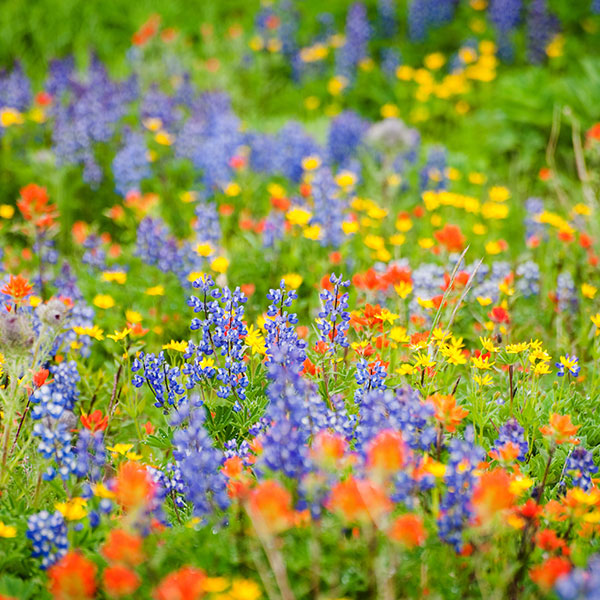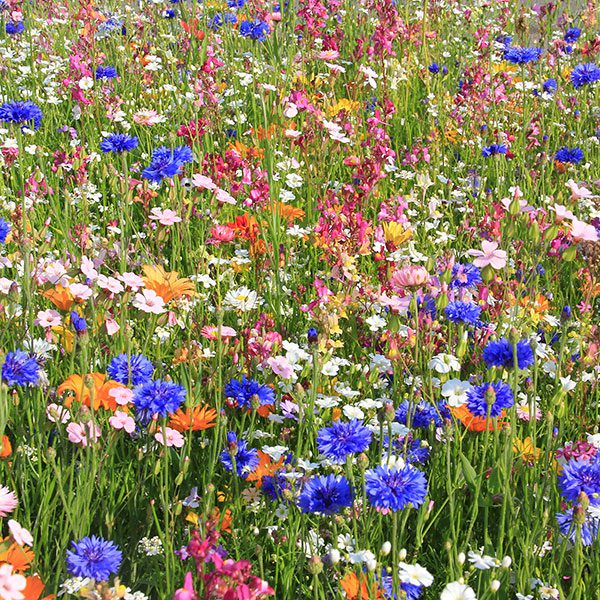How to Plant a Wildflower Meadow
Step One: Decide When to Plant Wildflowers
It is a pleasant surprise for many gardeners to learn that Flower & Wildflower seed can be successfully installed at various times throughout the growing season. Though spring is the most common and conventional time of the year to sow flower seed; successful results can also be achieved by planting in summer and fall as well. This seasonal versatility is a great advantage to the flower & wildflower gardener and brings many diverse benefits and possibilities.
Spring Planting: For most temperate regions of the United States, spring planting is best carried out within a month or so after the final frost of the winter season. The exact date will naturally vary based on your region and the severity of the winter season. The important thing is to not ‘jump the gun” and plant too early; if seeds are installed prior to a late-season frost, they will be lost for the season and will need to be re-seeded.
Summer Planting: Summer planting is advisable for cooler areas where temperatures don’t hover at 80 degrees or more for long periods of time.
Fall Planting: Though it may seem unusual to plant flower seeds in fall, it is actually the preferred time of year for many seasoned wildflower gardeners. The main benefit: a jump-start in bloom the following spring! However, if you do decide to plant your seeds in the fall, the trick is to do so after the first killing frost of the season and when the ground is almost frozen to eliminate any chance of germination. Use caution when considering the best time to plant as weather patterns can never be guaranteed.
Step Two: Where to Plant Wildflowers
It may sound obvious enough, but choosing the most advantageous site on your property is a very important determinant in the eventual success of your wildflower meadow. The most important factors to consider in this regard are the amount of average daily sunlight, the relative quality of the soil, and the accessibility to a water source like a hose or a sprinkler.
Though many wildflowers do tolerate some filtered shade – and a few actually thrive in it - the vast majority are definitely sun-lovers and will likely demonstrate the strongest bloom where exposure is greatest. Therefore, the general rule of thumb when considering the optimum planting site on your property is “the more sun the better”. This naturally means that areas with little or no tree coverage and as little obstruction from any structure such as a house, garage, or barn are best.
Soil too is sometimes a consideration when planting flowers, but it’s important to keep in mind that wildflowers will generally sprout in all but the most difficult conditions. This means that pampering your site with fertilizer or rich sod is not usually necessary. In fact, doing so can sometimes achieve the opposite result by inviting unwanted weeds and grasses. Only in the poorest of conditions, where the soil is literally sterile, is using an accelerant advisable.
Lastly, when choosing the best site for your seed installation, the availability of a steady watering source is helpful, but not usually necessary. In most regions and during most seasons, natural rainfall will be sufficient to provide the water necessary for a successful bloom. However, if you live in a particularly arid region, are planting during drier months, or are simply experiencing prolonged drought, it will definitely be to your advantage to water your site every other day or so for the first few weeks after planting until root growth is established.
Step Three: How to Plant Wildflowers
Clear Existing Growth & Loosen the Soil:
This is an absolutely vital step in the installation of any successful wildflower seed project. Though it may sound tempting to randomly cast your seeds into thin air and hope they will sprout, it is simply a waste of time and money to do so on a site that has not been properly prepared for planting. Though wildflower seeds are tenacious by nature - and a few might even persevere under the most inhospitable of circumstances - they, like all seeds, will perform best when rid of noxious weeds and grasses.
There are several ways to effectively remove existing growth and cultivate your soil, and the size of the site will typically be the deciding factor in which method is ultimately chosen. For smaller sites, a rake, hoe, or shovel is often sufficient to do the trick of removing unwanted grass, weeds, etc., while for larger sites, a roto-tiller is often the preferred method. Regardless of what tool or machine is used, the important thing to remember is that the more growth that can be removed, and the more the soil can be loosened, the better the environment for which your seeds to ultimately thrive. Of course, also keep in mind that, after all, these are “wild” flowers, not roses, and so naturally there will be competition from weeds and grasses.
The bottom line is: work the soil as best you can, but don’t panic when some weeds sprout along with the flowers!
Sow Your Seed!
So now you’ve got some sweat on your brow and you’re ready to plant! There are many effective installation techniques, but again, the size of the project will probably determine which makes the most sense for you. The two methods that are probably most advisable for the home-owner are:
1) The Hand-Broadcast Method (for smaller jobs): Simply scattering the seed evenly over the site by hand.
2) The Rotary or “Cyclone” Seeder (for larger jobs). This method accomplishes the same results through the use a hand-cranked spreader that can be purchased relatively cheaply at any garden center.
If seeding an area of several acres or more, hydro-seeding is our recommended method, and we invite you to contact us for information if your plans to call for such a sizable project.
Regardless of which sowing method you choose, we strongly recommend mixing your seed with regular “sand box” sand at a ratio of about 5 parts (sand) to 1 part (seed). This allows for a more even distribution and also provides a convenient way to mark which portions of the site have been seeded and which have not. This is not a required method for a successful planting, but most will find it a simple, affordable, and practical step.
After sowing, we recommend that you lightly compress your seeds into the soil – no more than a ½ inch - so as to protect them from birds, wind disbursement, etc. The key here is to compress them, but not bury them. If the site is of a manageable size, you can accomplish this by simply walking over the portion that’s just been seeded, or if it’s a larger area, you might want to use a standard seed roller; often used when planting grass seed.
Step Four: How to Care for Wildflowers
There is little to do, besides sitting back and enjoying your meadow, once the seeds have been sown. There are a few things you can do, however, to keep the blooms looking their best. Regular weeding of the area will keep the nutrients in the ground going to your flowers. During dry spells, make sure the flowers stay watered. When the blooming season is coming to a close, dead head spent blooms to promote future growth.


